
UNIQUE RECORDER FOR THE SERIOUS AMATEUR
THE EQUIPMENT: Ferrograph 724, a three-speed, quarter-track stereo tape recorder with built-in record/ playback amplifiers and speakers. Dimensions: 16 1/2 by 17 by 9 3/4 inches. Price: $649. Manufacturer: The Ferrograph Co., Ltd., London, England. U.S. distributor: Elpa Marketing Industries, Thorens & Atlantic Aves., New Hyde Park, N.Y. 11040.
COMMENT: The model 724 is a three-motor, three-head (erase, record, and playback), quarter-track stereo recorder in a portable case with a built-in monitor system (amps and speakers plus controls). Other Series Seven models include half-track mono and half-track stereo versions, deck models without the monitor system, and a high-speed model (available in half-track stereo only) that runs at 3 3/4, 7 1/2, and 15 ips. Other versions include 1 7/8 but not 15 ips.
The quarter-track deck, Model 704, costs $549 unmounted and can be bought with a walnut case for $50 more. All models take up to 8 1/4-inch reels. An excellent hard-bound manual covers all features in detail, filling seventy-five pages; our report will concentrate on those that are most unusual.
A first glance at the transport mechanism will reveal one of the features that sets the Ferrograph apart from other recorders: the variable-speed fast-wind control which you can use not only to move the tape rapidly back and forth but to hold it stationary.
Since the head arrangement allows some signal output in the fast-wind mode, searching for a particular portion of a tape is unusually easy with the Ferrograph.
There is a latch on the transport control's stop position so it cannot inadvertently be thrown directly from fast wind into play, damaging the tape. Like some other features of the Ferrograph, the latch takes a little getting used to, but it is well worth the trouble in terms of the extra protection it affords.
Another feature of the transport that is, as far as we know, unique on home recorders is a pair of screwdriver adjustments to raise and lower the reels so that each can be set for optimum height for even winding no matter what sort of reel is used.
The transport is solenoid-operated. This means, for one thing, that the 724 can be operated from a time clock without endangering pressure rollers or other drive parts. It can be preset in the record mode, but the drive mechanism will not engage until the AC power is turned on by the clock. It also can be started and stopped remotely by an accessory switch connected through a special DIN receptacle on the jack panel. The start-solenoid is defeated automatically when metal foil passes a sensor to the left of the heads, when the right tension arm touches a conductive stud-as it does if the tape breaks or runs through-or when either the speed-change control or equalization switch is moved. In any of these instances, a "reset" light next to the turns-counter flicks on and the transport stops. To get things going again, the transport control must be set in the "stop" position and the offending condition removed-either by rethreading the tape or by putting tape speed and equalization back in step with each other. The design may sound rather complex and requires some thought at first; but it, together with the fast-wind latch, constitutes a system that works well in use and, in our opinion, offers a lot of protection to both tape and recorder at minimum cost. Curiously, however, loss of tape tension does not stop the transport if, for instance, the take-up reel motor fails. This fault could easily be corrected, and we hope it will be in future models.
The use of separate speed-change and equalization controls will annoy some users at first, since many machines control both with a single switch.
One reason for the redundancy appears to be that the Ferrograph is doing more with its equalization switch than a home recorder usually attempts. Not only does it alter response-curve characteristics (equalization in the usual sense) but it changes record bias as well, optimizing it individually for each speed.
============
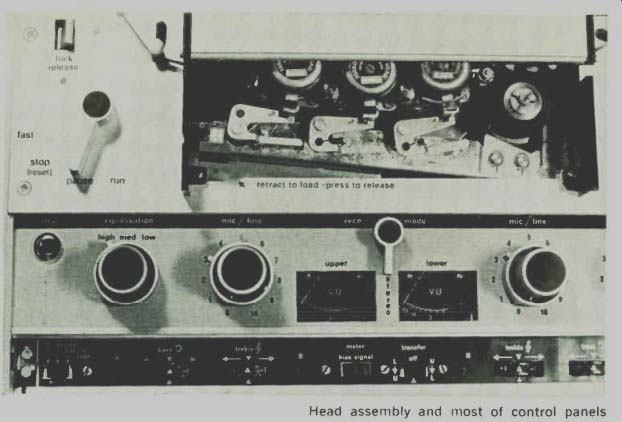
-------- Head assembly and most of control panels
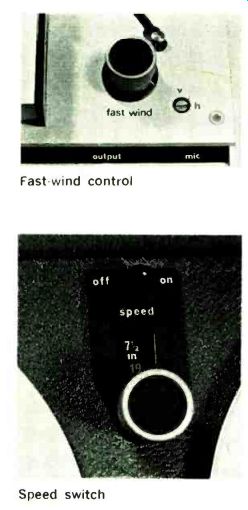

-------- Fast-wind control; Speed switch; Turns counter and record
controls
UNUSUAL CONTROLS REFLECT FEATURES THAT SET THE FERROGRAPH APART
With the head cover open, as it is in the top photograph, the threading button at the lower left corner of the well can be used to lock pressure pads out of the way for threading. To the left of the well is the transport control and above it the latch that must be released to move from the fast-wind mode into "pause" or "play." In the photograph at left, the fast-wind knob is shown set for maximum forward speed. As it is turned counterclockwise, it progressively reduces the speed of tape travel, stops it, then begins rewinding at increasing speed until the knob reaches maximum rotation. The screwdriver control next to the fast-wind knob compensates the tension arm (not shown) for the position-vertical or horizontal-of the machine. Similar screwdriver controls near reek set their height, compensating for different flange thicknesses.
Equalization switch is at left of main control panel and must match setting of the speed control between the tape reels. Otherwise, transport stop: and the "reset" light on the turns-counter escutcheon lights, signaling trouble. The same escutcheon also holds the "record" button, which can be pressed in play mode-though head cover just below it protects against accidental activation. The unmarked latch at the upper left corner of the head cover will release the record button without stopping the transport.
The record-mode switch between the meters is set for stereo. Moving it to the left (toward "upper" channel meter) changes mode to mono, recording in the left channel only; to right, recording is on right channel only.
Screwdriver controls marked "B" on bottom panel set bias; those marked "A" set playback level. All controls on this black panel are hidden by an aluminum trim strip when they are not in use.
============
Another unusual feature--though it is standard on many professional decks--is a record function that can be activated while the transport is in the play mode. Recorded material can be monitored to pick up a cue, the record button depressed, and new material substituted over the remainder of the old without missing a beat. The catch is, of course, that there is no record interlock: accidental activation of the record button during play will erase the tape.
To prevent this, the record button is placed between the reels, beyond the head cover. In practice, that position appears to be out of harm's way; we encountered no situation that threatened accidental erasure during our in-use tests. Without a pilot light or other visual indicator, however, one must examine the record button to tell whether the unit is set for record or for play. We understand that Ferrograph plans to improve the situation by adding illumination to the record meters and lighting them only in the record mode.
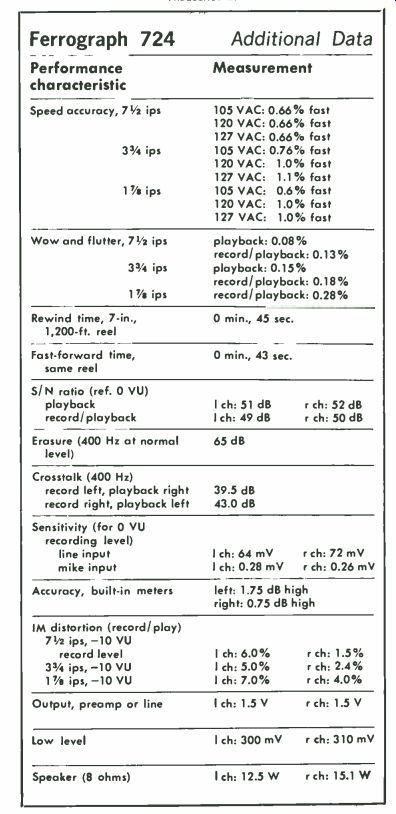
-------------Ferrograph 724 Additional Data
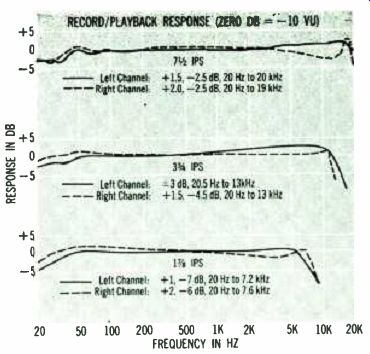
-------------
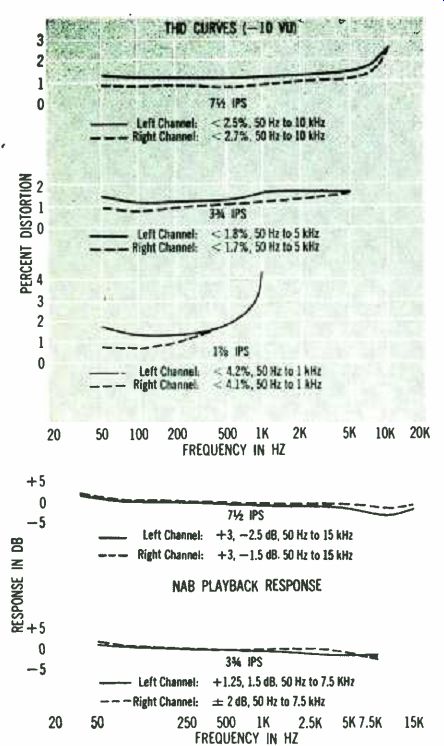
------------- RECORD/PLAYBACK RESPONSE
The electronics section of the 724 has all the usual controls, including a multi-play (sound-on-sound) feature. In addition, there are features normally found only on professional decks, particularly in the bias and monitor controls, concealed under a trim strip at the front (bottom when the unit stands vertically) edge of the front panel. Bias can be read on the meters and adjusted by separate screwdriver controls for each channel. (The manual lists optimum bias settings for several types of tape, and further explains how to determine optimum bias for any tape.) When the meters are monitoring audio and the monitor switches are set to "normal," both meters and speakers respond to input signals during recording and output signals during playback. But they can also be switched to respond only to input or only to output. In addition, the playback level can be adjusted for each channel so that it will match input level no matter what sort of tape or bias settings are being used. The ability to meter output can be helpful and is, moreover, necessary in setting bias for a tape that is not included in the manual's table of recommended settings.
But for use with standard receiver monitor circuits, it would have been an advantage had the normal position fed input to the meters during recording while continuing to feed output from the tape to the receiver's monitor system for aural quality checking.
There are actually two monitor circuits in the 724. After passing through the switching we have just described, signals are fed both to the normal tape output jacks and-via gain, treble, and bass controls for each channel-to the built-in amps and speakers. On deck models, this second set of signals goes to separate jacks on the rear panel, allowing the use of tone controls as equalizers in dubbing poorly balanced program material to a second recorder. The tone control knobs, mounted with only a portion of their periphery showing at the edge of the hidden control panel, raised some eyebrows during our tests. Calibration is printed on strips of adhesive-backed paper affixed to the edges of the controls. The ends of these strips worked loose during use and, while they did not affect operation, the design seemed inconsistent with the over-all quality of the unit. Ferrograph apparently agrees, since we understand that a new method of calibration is being devised.
The quality of the unit is excellent. It is, with some minor reservations as noted, solidly built and well finished--as Ferrographs traditionally have been. Comparing the accompanying specs with those of other recorders, you will find that the 724 generally falls precisely in the class you would expect: among the best of home recorders. And our test results are consistent within normal tolerance limits--with the specifications published by the manufacturer.
The overriding consideration in evaluating the Series Seven recorders, we believe, is the outstanding combination of features they offer. For the most part, these features strike us as well designed to operate and interrelate effectively as a system. That system requires practice on the part of the user if he is to reap the inherent benefits of its versatility and quality; but thorough familiarity is a requirement for the effective use of any recorder.
----
[REPORT POLICY Equipment reports are based en laboratory measurements and controlled listening tests. Unless otherwise noted, test data and measurements are obtained by CBS Laboratories, Stamford. Connecticut. a division of Columbia Broadcasting System, Inc., one of the nation's leading research organizations. The choice of equipment to be tested rests with the editors of HIGH FIDELITY. Manufacturers are not permitted to read reports in advance of publication, and no report, or portion thereof, may be reproduced for any purpose or in any form without written permission of the publisher. All reports should be construed as applying to the specific samples tested; neither HIGH FIDELITY nor CBS Laboratories assumes responsibility for product performance or quality. ]
----
(High Fidelity)
Also see:
Stanton Model 881S phono cartridge (Equip. Report, Nov. 1977)